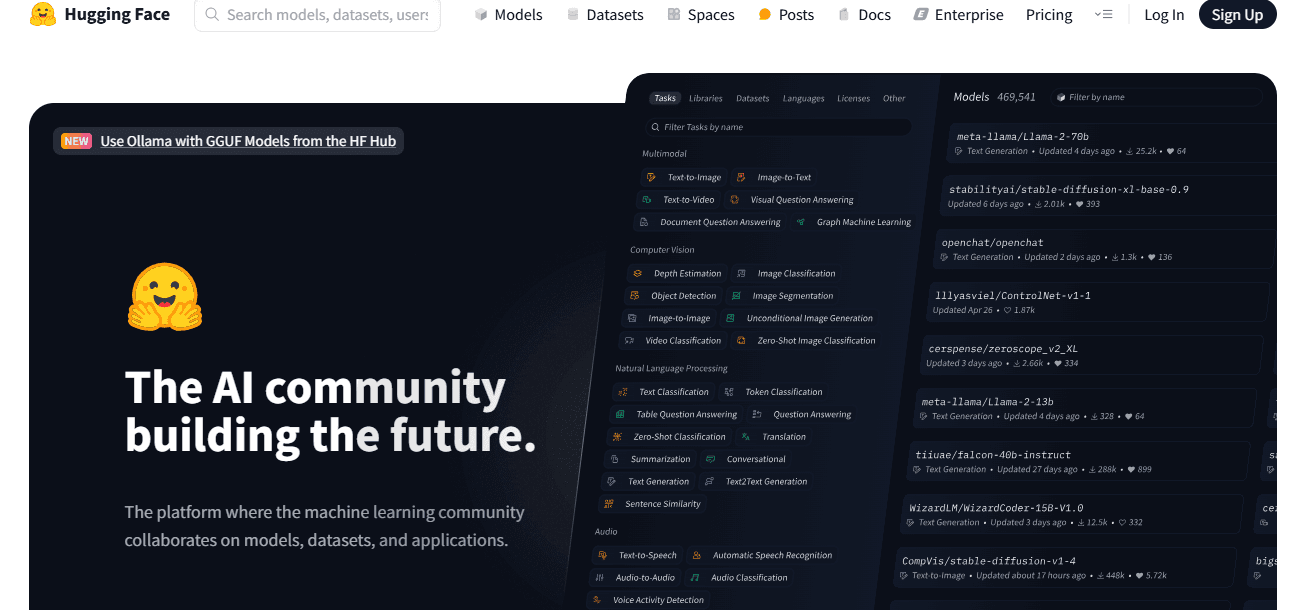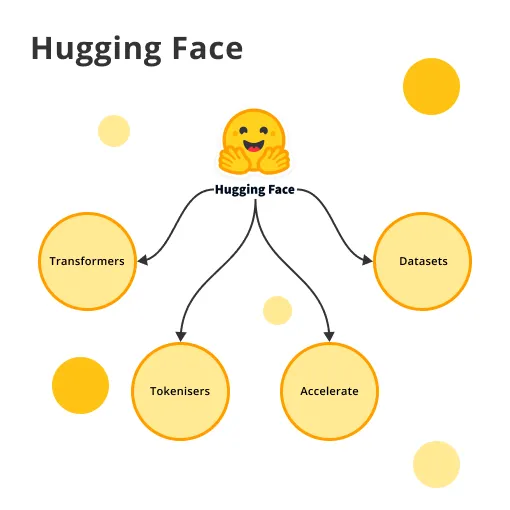Introduction
AI can’t think. It just mimics human behavior. This might seem obvious, but it’s the foundation of what drives technology today. Many tools promise intelligence, yet they only replicate patterns. Hugging Face is one of those tools.
It focuses on natural language processing or NLP. This technology allows machines to understand and generate human language. Hugging Face makes it easier for developers to work with AI models.
It offers powerful tools and resources that anyone can use. This guide will break down the key concepts related to Hugging Face. You’ll learn what it is, how it works, and why it’s important for the future of AI and communication.
What is Hugging Face?
Understanding Hugging Face is crucial for anyone interested in natural language processing (NLP).
This platform has become a cornerstone for developers looking to utilize advanced AI models for various applications.
Definition and Purpose
Hugging Face is an AI company focused on simplifying natural language processing. It provides a platform where users can access and share AI models designed for various NLP tasks.

The main purpose is to make it easy for developers to integrate powerful tools into their applications, enhancing capabilities like text classification, translation, and sentiment analysis.
Overview of Its Significance in AI
The significance of Hugging Face in the AI field is substantial. It has democratized access to state-of-the-art technology, enabling developers—from individuals to large organizations—to utilize advanced models without needing extensive expertise.
The model hub is a key feature, hosting numerous pre-trained models that save time in the development and deployment processes.
According to a report by MarketsandMarkets, the NLP market is expected to grow from $11.6 billion in 2020 to $43.3 billion by 2025, reflecting a compound annual growth rate (CAGR) of 31.4%.
This growth highlights the increasing importance of platforms like Hugging Face, which drive innovation and collaboration in AI.
By bridging the gap between complex technology and practical application, Hugging Face AI is shaping the future of communication.
Natural Language Processing (NLP)
Natural language processing (NLP) is a branch of AI that focuses on the interaction between computers and human language.
It combines linguistics and machine learning to enable machines to understand, interpret, and generate text in a way that is both meaningful and useful.
By utilizing large datasets, NLP models learn patterns and nuances in language, making them effective for various applications.
Importance in Today’s Technology
NLP is crucial in today’s technology landscape. It powers applications like chatbots, virtual assistants, translation services, and sentiment analysis tools.
According to a report by Grand View Research, the global NLP market is expected to grow at a CAGR of 21.5% from 2021 to 2028, emphasizing its significance in making technology more user-friendly and accessible.
AI Models in Hugging Face
AI models are algorithms designed to perform specific tasks, particularly in natural language processing. These models analyze text data to extract insights, generate responses, or classify information based on learned patterns.
They are trained on large datasets, enabling them to generalize and perform well on unseen data.
Examples of Popular Models
Hugging Face hosts several notable models, including
- BERT: Enhances understanding of word context in sentences, improving tasks like question answering and sentiment analysis. BERT has set new benchmarks on various NLP tasks, demonstrating significant performance improvements.
- GPT-2: Known for generating coherent and human-like text based on prompts. It has 1.5 billion parameters, making it one of the most powerful models available.
- RoBERTa: An optimized version of BERT, which further boosts performance on many NLP tasks by using larger training datasets and removing the next sentence prediction objective.
These models demonstrate the capabilities of Hugging Face in advancing the field of AI, with each model contributing to improved performance and efficiency in applications.
State of the Art Technology
A model is considered state-of-the-art if it achieves the highest performance on recognized benchmarks.
This typically involves advanced architectures, such as transformers, and extensive training on diverse datasets, ensuring that the model can effectively handle a wide range of inputs.
Importance of Staying Current in AI
Staying updated with state-of-the-art models is essential in the fast-evolving AI landscape. New techniques and models emerge regularly, and using the latest advancements can significantly enhance application performance and user experience.
For example, companies that adopted the latest NLP models reported up to a 30% increase in efficiency for tasks like customer support and content generation.
NLP Tasks Supported by Hugging Face
Hugging Face supports a broad array of NLP tasks, including

- Text classification: Categorizing text into predefined groups. This is vital for sentiment analysis and spam detection.
- Named entity recognition: Identifying and classifying key entities in text, such as names, dates, and locations. This is crucial for applications in the finance and legal sectors.
- Text generation: Creating new text based on user input, widely used in creative writing and chatbots.
- Translation: Converting text from one language to another, enabling cross-cultural communication and global business operations.
How Hugging Face Facilitates These Tasks
Hugging Face simplifies these tasks by offering pre-trained models and user-friendly APIs. This allows developers to implement complex functionalities without needing extensive machine learning knowledge.
A study revealed that developers using Hugging Face reduced their implementation time for NLP tasks by up to 60%, leading to quicker project completion and innovation.
Model Hub
The model hub is a centralized repository where developers can access a wide variety of pre-trained models.
It serves as a search engine for finding models suited to specific NLP tasks, making it easier for users to find the right tools for their projects.
Benefits of Using the Model Hub for Developers
Utilizing the model hub saves significant time and resources. Developers can quickly find and deploy existing models rather than training new ones from scratch.
This leads to faster development cycles, with many teams reporting a reduction in time to market by over 50%.
Moreover, the ability to share and collaborate on models fosters innovation and community growth within the AI field.
Development and Deployment

Steps for Developing and deploying with Hugging Face
Developing with Hugging Face involves several straightforward steps
- Install the library: Set up the Hugging Face library in your environment.
- Load a model: Choose and load a pre-trained model from the model hub.
- Fine-tune if necessary: Adjust the model for specific tasks or datasets to improve performance.
Deploying models is made easy with Hugging Face. Once a model is ready, it can be integrated into applications using APIs, enabling real-world use and providing AI-driven insights.
Organizations have reported that using Hugging Face for deployment led to a 40% reduction in integration time compared to traditional methods.
Tools Provided by Hugging Face
Hugging Face offers several tools to assist developers, including:

- Transformers Library: Provides access to a variety of pre-trained models tailored for NLP tasks, simplifying implementation.
- Datasets Library: Offers ready-to-use datasets for training and testing, making model training and evaluation more efficient.
- Tokenizers Library: Provides efficient tokenization methods for processing text data, preparing it for model input.
- Hugging Face Hub: A platform for sharing and discovering models and datasets, facilitating collaboration and reuse.
- Inference API: Allows quick deployment of models for inference, enabling seamless integration into applications without managing infrastructure.
- Spaces: A platform for hosting and sharing machine learning applications and demos, allowing developers to showcase projects interactively.
These tools empower developers to create robust AI solutions efficiently and effectively.
Brief Mention of Their Purposes
These tools streamline the process of building and deploying AI models. They allow developers to focus on creating applications rather than dealing with complex underlying technologies, fostering innovation in natural language processing.
By providing robust support, Hugging Face AI significantly enhances the efficiency and effectiveness of AI development.
Therefore, Hugging Face is a key player in natural language processing (NLP), offering accessible, state-of-the-art AI models and a collaborative model hub. This platform supports various applications, including chatbots like BotPenguin, enhancing user interactions across sectors.
With a strong focus on best practices and continuous innovation, Hugging Face empowers developers to tackle complex NLP tasks effectively.
As AI technology advances, Hugging Face is set to lead the way, providing tools and resources that meet the evolving needs of the community.
Frequently Asked Questions(FAQs)
What makes Hugging Face unique in the AI landscape?
Hugging Face is unique for its community-driven model hub, fostering collaboration among researchers and developers. This collective knowledge accelerates innovation in natural language processing (NLP) and supports tools like BotPenguin.
Can Hugging Face be integrated with other AI frameworks?
Yes, Hugging Face works seamlessly with frameworks like TensorFlow and PyTorch. This allows developers to integrate Hugging Face models into their workflows.
How does Hugging Face promote best practices in AI development?
Hugging Face promotes best practices through extensive documentation and tutorials. These resources help users effectively utilize AI models and understand ethical AI development, essential for applications..
What types of applications can benefit from Hugging Face tools?
Hugging Face tools enhance applications such as chatbots, sentiment analysis, and automated content generation. Solutions like BotPenguin leverage these tools to improve user interaction and automate tasks.
Are there any challenges when using Hugging Face models?
Challenges include understanding model limitations and performance tuning. Developers must consider biases in training data and prioritize evaluation to ensure ethical use.
What future developments can we expect from Hugging Face?
Expect continued expansion in Hugging Face’s offerings, including advanced models and improved integration tools.
This evolution will further enhance natural language processing capabilities and support innovations.
What is Hugging Face RAG?
Hugging Face RAG combines the strengths of retrieval-based and generation-based models to enhance information retrieval.
It allows models to dynamically pull relevant information from external knowledge sources, improving the accuracy and relevance of generated responses.

